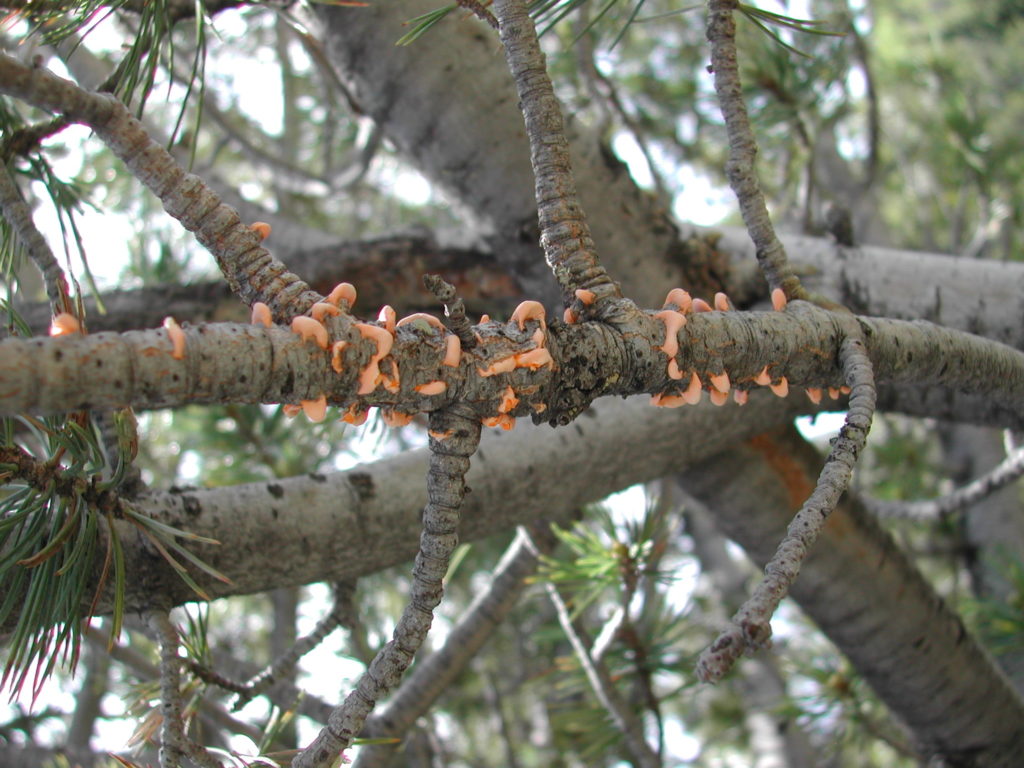Introduction
White pine blister rust is a fungal disease of white pine. It is caused by the fungus, Cronartium ribicola. The disease pathogen is native to Asia. It was inadvertantly introduced to North America in the early twentieth century. The fungus has since spread to at least thirty eight states, causing substantial damage to white pine populations.
Distribution & Habitat
White pine blister rust is native to Asia. Since being introduced to North America, the disease has been reported in at least thirty eight states. It occurs most frequently in the western United States, but may be observed wherever susceptible plants are present.
Hosts
White pine, currant, and gooseberry are the three most common hosts for white pine blister rust. Indian paint brush, lousewort, and snapdragon have also been reported as alternate hosts. White pine is vulnerable to white pine blister rust at all ages, though seedlings and young trees are most prone to infection.
Disease Cycle
White pine blister rust has a complex disease cycle that requires two hosts to achieve completion: a white pine, and an alternate host – most often a currant, or gooseberry. Spores are released by fruiting structures on secondary hosts. They are disseminated by air currents or splashes of rain to white pines, where they initiate new infections. The fungus germinates on the plant surface, infiltrating the host through the stomata on the needles, or through bark wounds. Once the fungus has become established within the host, it proceeds to develop, and expand. The fungus continues to grow within the twig for a year or more. As the infection progresses, blister-like fruiting structures erupt through the bark of the twig, or stem. These fruiting structures contain bright orange aeciospores, which are released when conditions become sufficiently moist. The aeciospores are dispersed by the wind or rain to alternate hosts, which they readily infect. The fungus develops within these new hosts, causing fruiting structures to arise. These fruiting structures rupture in fall, releasing basidiospores that are dispersed by air currents and rainfall to the foliage of white pines, which are rapidly infected. The infected gooseberry or currant is relieved of the disease in fall when the plants shed their leaves. Rust infections of white pine can persist for years.
Symptoms of Infection on White Pine
On white pine, the initial symptoms of infection may be subtle. At first, small clorotic spots may appear on a few infected needles. As the fungus expands into the branches, spindle-shaped swellings form, and develop into cankers. Cankers can generally be identified as swollen masses, with a greenish-yellow to orange margin. Rodents may occasionally gnaw on the bark at the canker margin. As the cankers enlarge, they girdle the branch or stem, killing the healthy tissue. If a canker forms on the main stem, it will cause the crown to wilt, and die back. This often results in tree mortality. Cankers often exude large amounts of resin, which can be observed glistening on the bark.
The fruiting bodies, or pycnia, develop at the canker margins a year or two after the canker has formed. They resemble small honey-colored droplets, and contain a multitude of pycniospores. The fruiting bodies are visible from late spring to early summer. Aecia develop in this region of the canker the following year. As the canker grows, the sequence of pycnial and aecial development will alternate, so long as the fungus remains active within the host.
Symptoms of Infection on Currant and Gooseberry
On currant and gooseberry, infections of white pine blister rust are not as conspicuous. When infected, the leaves of currant and gooseberry will develop chlorotic spots on the upper leaf surface. If the leaves are severely infected, they may drop prematurely. Orange pustules may form on the underside of the leaves, just below the chlorotic spots.
Management
- Infected white pines can be culled to reduce the incidence of infection.
- Apply pruning cuts to the lower branches of young trees to promote air circulation, and increase tree vigor. Pruning of young trees should occur periodically, over several years. No more than one third of the branches should be removed at any time.
- Diseased, and cankered branches should be removed from infected plants. Removing branches with cankers exceeding four to six inches is not feasible. In such instances, the removal of the tree is recommended.
- When planting, select varieties with an increased resistance to the disease. ‘Paton’s Silver Splendor’ is a variety of eastern white pine that is resistant to white pine blister rust. Many cultivars of currant and gooseberry exhibit resistance to the disease, including jostaberry, ‘Consort’, ‘Coronet’, ‘Crusader’, ‘Red Lake’, ‘Viking’, and ‘White Imperial’ currant, and ‘Achilles’, ‘Columbus’, ‘Colossal’, ‘Oregon’, and ‘Sabine’ gooseberry.
- Maintain tree vigor through sound cultural practices. Ensure that trees are sufficiently watered, especially during extended periods of drought. Apply a layer of organic mulch around the base to improve soil quality, moderate soil temperature, and maintain soil moisture.
Photo courtesy of US Forest Service


